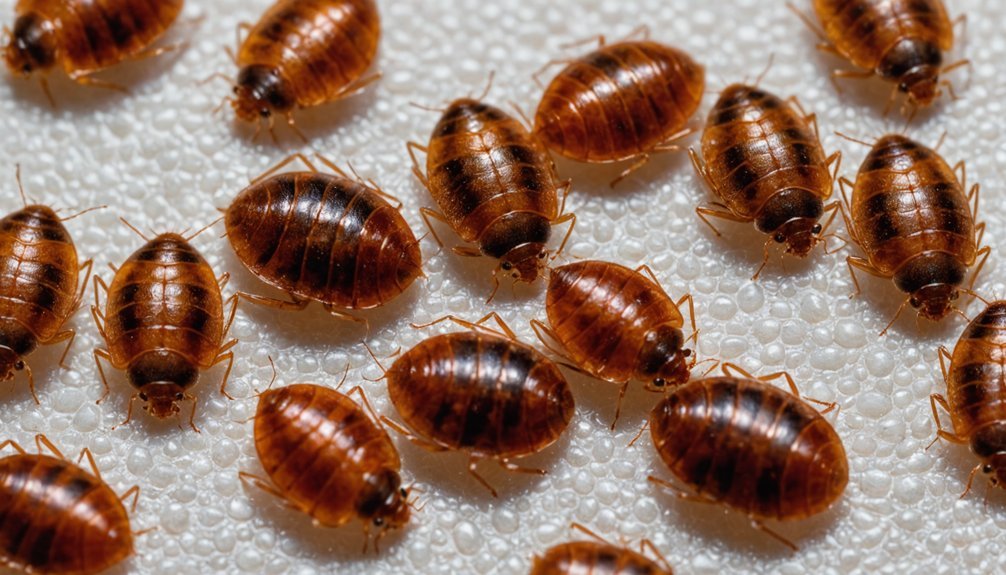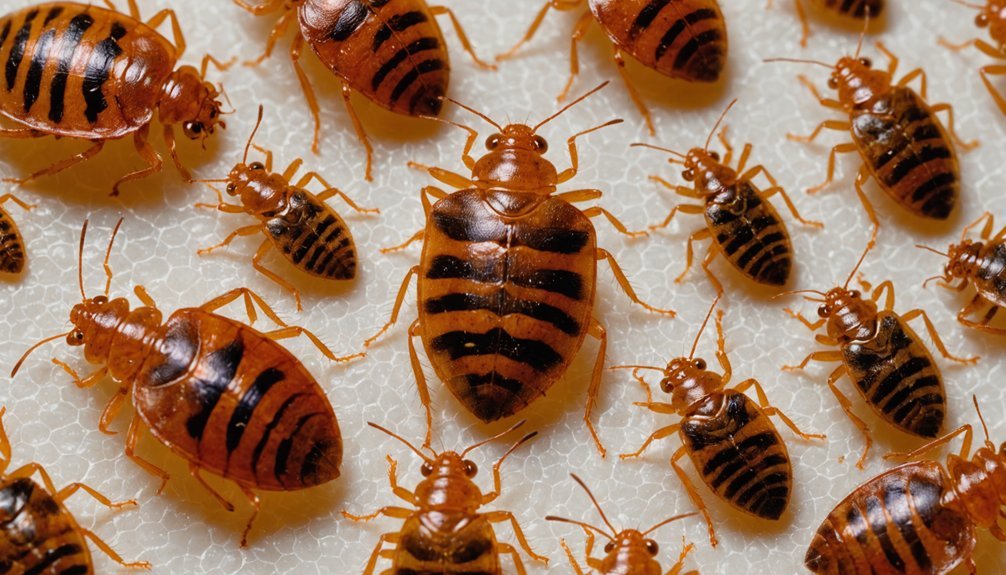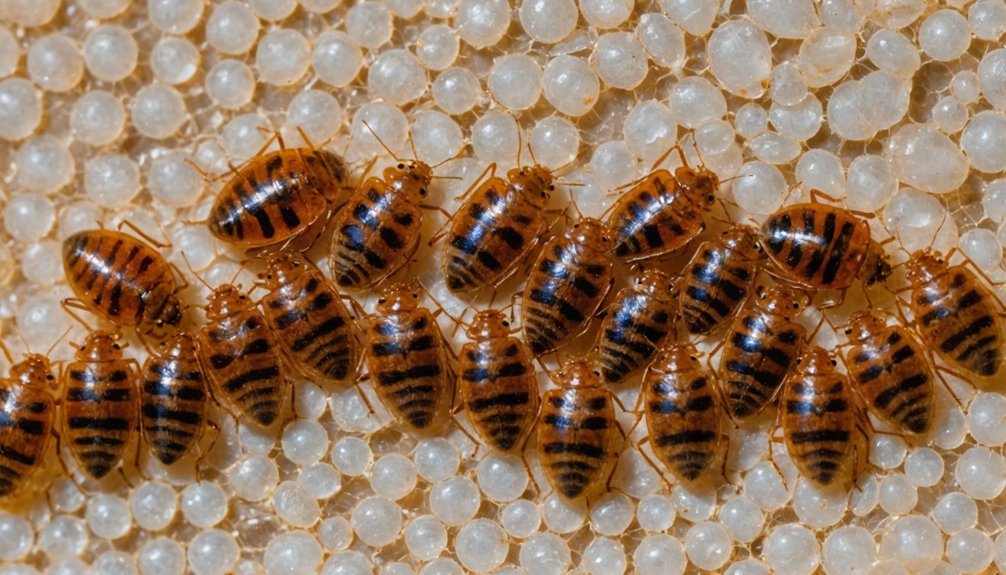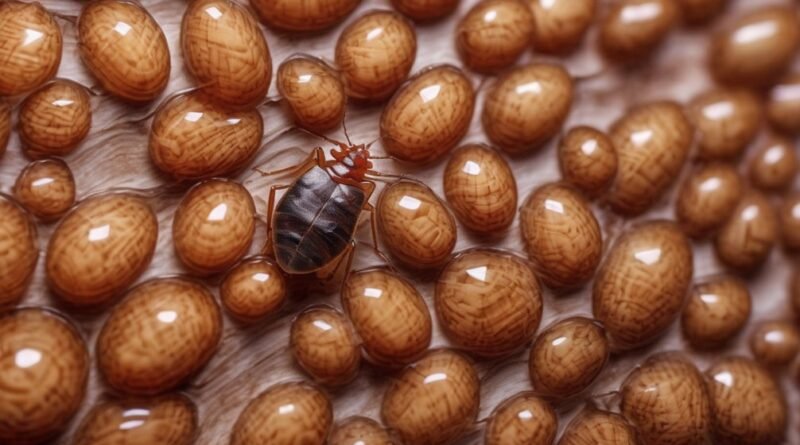Bed Bug Identification Guide: Eggs, Nymphs, Adults & Signs
Spot bed bugs by knowing each stage. Eggs are pearly white, 1 mm, clustered in seams; dark eye spots appear after five days. Nymphs hatch in 5–10 days, pass five molts, and must feed each time; they start translucent and turn reddish after meals. Adults are flat, mahogany-brown, 4–5 mm (up to 13 mm fed), feeding every 5–7 days. Look for rusty smears, fecal spots, shed skins, live bugs, and a sweet musty odor. You’ll soon recognize every sign.
Key Takeaways
- Eggs are 1 mm, pearly white, laid in clusters along seams; fresh eggs are translucent, developing dark eye spots after five days.
- Nymphs hatch in 5–10 days, start translucent yellow, and require a blood meal to molt through five instars.
- Adults are flat, oval, wingless, 4–5 mm unfed, expanding after feeding; males have pointed tips, females rounded abdomens.
- Common signs include rusty blood smears, dark fecal spots, translucent shed skins, live bugs in folds, and a sweet, musty odor.
- Bites present as small, itchy welts on exposed skin, often in clusters or lines, appearing after nighttime feeding.
Egg Appearance and Development Timeline

Although tiny, bed bug eggs are distinctive: they’re about 1 mm long, pearly white, and smoothly oval, often resembling pinhead-sized grains of rice that stick to surfaces with a glue-like coating.
You’ll spot them singly or in small clusters along seams, crevices, and other sheltered spots. Fresh eggs look translucent and slightly shiny; as they age past about five days, a small dark eye spot becomes visible. Dead or decaying eggs turn shriveled, yellowish, or brown. Bed bug eggs adhere firmly to surfaces with a glue-like substance, making them difficult to remove.
Expect a steady trickle rather than a burst. After one blood meal, a female lays 1–7 eggs per day for roughly 10 days, totaling about 5–20 eggs from that feeding and around 113 eggs over her lifetime.
Under favorable conditions, about 97% of eggs hatch. At room temperatures above 70°F, roughly 60% hatch by day six and over 90% by day nine. Cooler rooms extend hatch times by several days, slowing overall emergence.
Nymph Stages and Growth Requirements
After hatching, bed bug nymphs pass through five instars, each separated by a molt and dependent on a blood meal to advance. You’ll see stage 1 nymphs as translucent yellow, about 1–1.5 mm long; they darken after their first feeding.
Stages 2–4 appear brown and gradually grow to roughly 4–5 mm by the fifth instar. Across these stages, the exoskeleton becomes thicker and more opaque, and shed skins may collect near hiding spots. Bed bugs can survive months without feeding, which helps infestations persist unnoticed.
Nymphs typically emerge in 5–10 days at room temperature. They feed for about 3–10 minutes per meal, usually at night, and each stage requires at least one successful feeding to molt.
Development speed hinges on temperature, humidity, and host access; under favorable conditions, the full nymphal period can finish in a few weeks. Without a host, nymphs can endure for several months, and at cooler temperatures they may survive up to a year, though progress stalls until they feed.
Adult Morphology and Lifespan

Compact and purpose-built, adult bed bugs are flat, oval, and wingless—shaped like tiny apple seeds to slip into tight seams. You’ll notice a distinctly flattened profile when unfed, with pad-like vestigial front wings and six legs tipped with claws for gripping. Look for reddish-brown fecal spots on nearby bedding or upholstery as a clear sign accompanying adult sightings. In addition to their distinct shape, what bed bugs look like includes a range of sizes, typically measuring about 4 to 5 millimeters in length. They can appear more swollen and darker after feeding, shifting from a flat shape to a more rounded form. Observing these characteristics can help in identifying an infestation before it worsens.
Males have a pointed abdominal tip; females’ abdomens look smooth and rounded. Antennae span about half the body, helping them locate hosts, while a needle-like proboscis delivers anticoagulant saliva during feeding.
Adults typically measure 4–5 mm long and 1.5–2 mm wide, though some reach 4–7 mm by 2–3 mm. After a meal, the abdomen expands—up to about 13 mm—and the eleven abdominal segments allow that stretch. They’re sexually mature and don’t molt again.
- Travel speed: up to four feet per minute.
- Feeding: about 0.0055 mL of blood every 5–7 days when hosts are available.
- Longevity: can survive up to 70 days without feeding at any stage.
Size and Color Changes Across Life Stages
From egg to adult, bed bugs shift noticeably in both size and color. You’ll spot eggs first: tiny, grain-like capsules about 1 mm long, pearly to milky white, often translucent enough to hint at the developing nymph. They blend into light surfaces and hide in tight seams.
Newly hatched nymphs start nearly invisible—clear to white, around 1–1.5 mm. After a blood meal, they darken quickly, showing a reddish tint through their translucent bodies.
As nymphs progress through five molts, they grow from about 1.5 mm to 4–5 mm and shift from translucent to yellowish-white, then yellow-tan, and finally yellowish-brown. Each stage requires a blood meal to molt and grow larger.
Fed nymphs look reddish-brown, while unfed ones remain paler. By the final instar, they’re sesame-seed sized, oval, and visibly segmented, closely resembling small adults.
Adults reach roughly 5.5 mm (about 1/4 inch long), with an oval, flattened shape. Their coloration settles into mahogany to reddish-brown, maintaining a consistent brown appearance.
Common Infestation Indicators and Bite Patterns

Knowing how bed bugs look at each stage helps you spot what they leave behind: telltale stains, skins, and bites. You’ll notice small rusty or reddish smears on sheets from crushed bugs or excrement, pinhead-sized pale eggs or eggshells tucked into seams, and pepper-like black dots (fecal spots) along mattress edges. Consistent signs like these over time can indicate a potential infestation.
Translucent shed skins collect near tufts, tags, and nearby furniture. During inspections, you may even see live bugs in folds.
Bites typically show up on exposed skin—hands, neck, face, shoulders, legs, and arms—as small, flat or slightly raised welts that itch, redden, or blister. They often form clusters or a tight line or zigzag because a single bug can feed, get disturbed, move, and bite again. Bite count doesn’t equal bug count.
1) Check hidden spots: seams, box spring creases, screw holes, baseboards.
2) Sniff for a sweet, musty odor—stronger in larger infestations.
3) Track patterns: clusters/lines on exposed areas.
Frequently Asked Questions
Do Bed Bugs Transmit Diseases to Humans?
No, you won’t find evidence that bed bugs transmit diseases to humans. You can get itchy bites, anxiety, and lost sleep, but current studies don’t show bed bugs as competent vectors.
Researchers have detected dozens of pathogens in them, yet transmission hasn’t been proven in people, and epidemiological data don’t show causal links.
Even lab attempts often fail to complete transmission cycles. Focus on eliminating infestations for comfort, not disease prevention.
How Do Bed Bugs Spread Between Apartments or Hotels?
Bed bugs spread between apartments or hotels by crawling through walls, outlets, and plumbing, and by hitchhiking on luggage, furniture, and belongings.
You should expect rapid expansion from a single infested unit. They move even without hosts and disperse 0–5% between units within about two weeks.
Turnover drives transmission as departing tenants relocate bugs. Adults can persist months in vacant rooms, so untreated adjoining units sustain reinfestations despite temporary vacancies.
What Home Treatments Actually Kill Bed Bugs Effectively?
Use high heat: wash infested fabrics hot 30 minutes, then dry on the highest setting 30 minutes.
Apply steam to mattresses, couches, and seams.
For contained items, heat in black bags on 120°F days or in a closed car 90 minutes.
Alternatively, freeze sealed items at 0°F for 4 days (verify with a thermometer).
Lightly dust cracks with silica aerogel or DE.
Use proven contact sprays (EcoRaider, Bed Bug Patrol) for direct hits.
Can Pets Carry or Attract Bed Bugs?
No, pets don’t attract bed bugs, but they can briefly carry them.
Bed bugs prefer humans for warmth and CO2, and they don’t live on animals like fleas do. They may hitchhike in fur after visits to infested places, then hide in beds, furniture, or crates near where you sleep.
Watch for bites, itching, or restlessness in pets, and inspect bedding.
Treat the environment, not the animal; consult a vet if reactions occur.
When Should I Call a Professional Exterminator?
Call a professional when bed bugs spread beyond bedrooms, you see eggs or dark spots, or a musty odor appears.
If DIY efforts fail and bites, stains, and sightings persist, don’t wait.
Extensive infestations—bugs in baseboards, furniture joints, outlets, or multiple rooms—need specialized tools, heat or chemical treatments, and multiple visits.
If anyone has allergic reactions, sleep issues, or sensitive health conditions, prioritize expert help for fast relief and a safer home.
Conclusion
You’ve got the essentials to spot bed bugs fast: recognize eggs and nymph stages, confirm adult traits, and track color and size changes as they feed and grow. Watch for stains, shells, and musty odors, and match bites to typical clustered patterns. Act quickly—inspect seams and crevices, launder hot, vacuum thoroughly, and use interceptors. If activity persists, call a pro. With vigilant checks and timely treatment, you’ll break the life cycle and reclaim your space.

